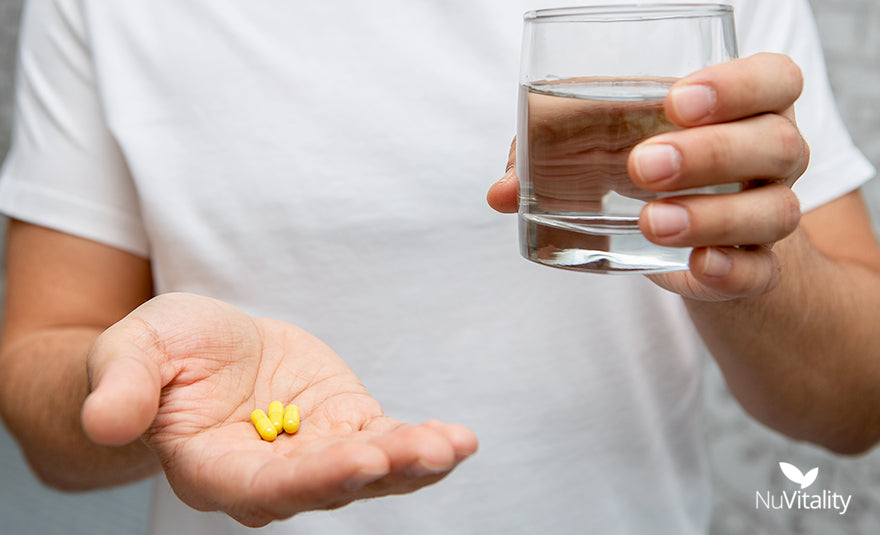
The human body is far more fragile than most people realize. We are dependent on our joints for locomotion, making any damage to them a catastrophic occurrence. Our joints are sensitive enough that physical trauma is all it takes to damage them, but there are also far more severe joint issues that can plague us.
Diseases like arthritis cause damage to our joints that make everyday life excruciating if we do not seek out some form of treatment. However, when we cannot seek out medical intervention, supplementary tools become necessary. In a world full of pharmaceuticals, some wonder what role a natural supplement like turmeric offers.
Turmeric is a rising star in the health world whose ascent has been centuries in the making. Since its discovery, this orange root has been used for cooking, fabric dyeing, and medicinal use. We are all looking to it as a possible solution to joint pain and even arthritis. However, we have to wonder just how effective turmeric curcumin is in combatting these issues or if it is simply ineffective. With this article, we hope to determine whether or not turmeric curcumin can be a reliable supplement for those of us who suffer from chronic joint pain or arthritis.
What Causes Joint Pain?
Joint pain is a widespread problem for most Americans. To the point that virtually everyone in the country has experienced it at one point in their lives. However, before we can understand how turmeric curcumin can help deal with the symptoms, we need to understand what can lead to joint pain in the first place.
The reality is that we are not as indestructible as we might have believed in our youth. While our joints were healthy and strong at first, they began to deteriorate with each passing year from when we started using them. Much like how a car loses value the second you drive it off the lot. While aging is a primary cause of joint pain, it can also be accelerated by specific events and diseases.

One of the biggest causes of joint pain is inflammation resulting from an injury or disease. Inflammation is actually meant to be a natural part of the human body's autoimmune response. Whenever we are wounded and need to heal, our bodies trigger an inflammatory response to shield the afflicted area while it works to heal the injury.
The problem is when the inflammation becomes a chronic event that constantly interferes with your basic motor functions. Despite being a healing process, inflammation is extremely painful and can cause damage to your bones, tendons, and cartilage (all of which are components of our joints). When chronic inflammation occurs, the damage to these areas results in consistent pain for the joints.
However, the inflammation is not solely caused by simply taking a form of physical trauma to your body. It can easily be triggered by certain diseases becoming more common in the average American. One of the most severe causes of chronic inflammation and joint pain is arthritis.
What Causes Arthritis?
Arthritis is easily one of the most common diseases in the country. According to the Center for Disease Control surveys, 24% of all American adults have arthritis. This translates to 58,500,000 Americans out of a population of 329,500,000 people. For a debilitating condition, the fact that it is so widespread is nothing short of terrifying and begs the question of how such a spread could have happened. The sad truth is that arthritis is so common because it is generally born from the wear and tear our bodies experience as we age. Years of constant physical stress will lead to damage and inflammation that causes the development of arthritis.

The inflammation caused by arthritis leads to damage to the joints themselves, which can yield an unpleasant range of symptoms:
- Stiffness
- Limited range of motion
- Instability
- Grating or scraping sensations in the knees
These are only a few, but they can all be extremely debilitating. The fact is that arthritis can severely impact your overall health. Generally, arthritis only starts to manifest between 30 to 60 years old. However, it can come earlier depending on your life experiences. Being exposed to constant physical trauma, for example, can lead to earlier development of arthritis in your joints, which means that finding ways to cope with the symptoms and pain is an essential aspect of living with arthritis. Arthritis is a more generalized term than most people realize. There are several variations of arthritic conditions that vary in severity and causes.
Osteoarthritis is the most common arthritic condition that can be worsened by infection or injury to the afflicted joint. It involves the breakdown of cartilage that causes the bones to rub against each other and cause pain and inflammation. Another common variant of arthritis is rheumatoid arthritis, which is an autoimmune issue. Rheumatoid arthritis results from the human body attacking itself and inducing extreme levels of inflammation in the synovium. In both cases, the inflammation is a leading cause of the more severe symptoms. This, of course, brings us around to what role that turmeric curcumin can play in treating arthritic symptoms.
Can Turmeric Treat Arthritis and Joint Pain?
Turmeric's use as a supplement has been on the rise for some time, thanks to curcumin's wide array of health benefits. It is no secret that curcumin has qualities that can be beneficial in treating the symptoms of arthritis and resolving joint pain. While the root is not a cure and will not be something you will be getting prescribed during a visit to your primary care physician, it is still worth investing in.
One of the most important benefits that curcumin offers is that it is an anti-inflammatory that can be used to reduce joint inflammation. Be it inflammation caused by external trauma or a direct result of arthritis, curcumin can be a powerful tool against it.
In 2019, a study was conducted to compare curcumin's effects to a commercial anti-inflammatory drug called diclofenac. The trial was made up of 139 patients suffering from chronic knee pain. The patients were divided into a test group and a control group, with the former taking 500 mg turmeric capsules three times a day. The latter group took a 50 mg diclofenac pill twice a day. Initially, the two substances seemed to share the same levels of efficacy in resolving the knee pain of the subjects. However, it eventually became clear that the curcumin was more tolerable to those with osteoarthritis.

Another study, this one from 2020, was conducted by researchers from the University of Australia. A group of 70 subjects was brought together, with each subject being at least 40 years old and suffering from osteoarthritis of the knee. Like the last study, the 70 subjects were divided into a test group and a control group to assess curcumin's effectiveness in treating osteoarthritis. The test group received 1,000 mg of curcumin a day, while the researchers gave the control group a placebo over 12 weeks. The results came to show that the curcumin supplement was vastly more effective than the placebo effect in reducing the levels of pain in the subjects.
Later, the participants filled out a questionnaire confirming that the curcumin significantly reduced their pain levels. These results prove that the curcumin found in turmeric is highly effective in managing the joint pain caused by arthritic conditions, among other causes.
However, the most shocking thing is that turmeric has been used in Ayurvedic medicine for centuries before it became popular in modern use. Its use was for the same purposes of combatting inflammation and the fact that it is non-toxic, which is more than can be said for NSAIDS like ibuprofen that might lead to toxicity and overdose.
Now that we know that curcumin can be viable for combating inflammation and joint pain, there is another issue to consider. Curcumin, despite its benefits, is not the simplest thing in the world to take advantage of due to its one major drawback.
Curcumin Is Difficult to Absorb
For all of its advantages and benefits, curcumin has a critical drawback that requires correction. Curcumin has extremely low bioavailability, making it very difficult for the human body to absorb the compound and distribute its effects to the afflicted areas. This low bioavailability renders raw turmeric root almost useless in treating joint pain and arthritis.
The amount of curcumin found in turmeric roots sits at a measly 2% to 5% per unit. Even when you consume curcumin, the low bioavailability makes it extremely difficult for your body to use it. Fortunately, there is a very easy way to boost the bioavailability of curcumin by a significant amount—black pepper.
Black pepper contains a compound known as piperine, which offers a remarkable effect on the bioavailability of other compounds. Research proves that when combined with curcumin, piperine enhances the absorption rate for the latter by a staggering 2,000%. One study, in particular, discovered that the addition of 20 mg of piperine to a 2 g serving of turmeric heavily increased the rate of absorption for the latter. However, the question of why piperine, of all things, can enhance the absorption rate of curcumin remains. There are currently two prevalent theories.

The first theory purports that the piperine can soften the intestinal wall and allows the curcumin to go straight through. This gives the curcumin a more direct route to your bloodstream and, consequentially, the rest of your body and maximizes the odds of absorption. The second theory is that the piperine inhibits the liver's ability to break the curcumin down. Meaning curcumin has a higher chance of being fully absorbed and enhancing the concentrations in your bloodstream.
Once the levels of curcumin you can absorb have been reinforced, you will find that it will heavily reduce the joint pain you suffer. Fortunately, a supplement option that enables you to enjoy curcumin with piperine included does exist. This is also important to the main purpose of this article since piperine itself has anti-inflammatory properties. This means that any supplementation of curcumin combined with piperine will allow you to double down on the anti-inflammatory relief afforded by either and lessen the strain of arthritis and joint pain. However, there are some dosage concerns.
What is the Proper Dosage of Curcumin?
Curcumin is considered an extremely safe supplement for human consumption, but the FDA does not regulate it. The typical dosage used in the studies we have mentioned is between 500-2,000 mg a day. However, no fully established dosage can be cited for curcumin. The World Health Organization (WHO) does offer a suggested dosage of 1.4 mg of curcumin per pound of body weight as an ideal baseline. The exact dosage of your supplement will likely be listed on the packaging and will be sufficient for your needs. However, you should avoid exceeding the printed dosage to avoid any side effects.

The only side effects to speak of when it comes to curcumin involve allergic reactions such as rashes, stomach pain, nausea, etc. However, these issues are best avoided, so following the dosage information on your supplement's packaging is an essential step. Otherwise, curcumin combined with piperine can be a powerful tool in your battle against joint pain and arthritis. The only remaining concern you should have now is acquiring a quality curcumin supplement.
The Nu You
Curcumin is perhaps the most valuable compound found in turmeric plants. Its value lies in the numerous health benefits it affords those who take it and its anti-inflammatory properties. The latter allows curcumin supplements to be an ideal tool for treating joint pain and arthritis. In addition, its ability to reduce inflammation means that curcumin can reduce the damage caused by arthritis and joint damage.
You can restore the quality of life to those suffering from either. Arthritis, while serious, is not necessarily a guaranteed condition. There are plenty of people who never develop symptoms and will enjoy relatively pain-free lives. That said, the likelihood of arthritis and trauma to the joints is great enough to ensure that you can combat these issues when they arise. However, finding a supplement with piperine is needed to make it viable and ensure the supplement comes from a reputable vendor.

To that end, we at NuVitality would like to extend an offer of assistance. We have made it our goal to offer health supplements using the most powerful natural products available. Curcumin is one of our main selling points for improving the health of our customers. Our turmeric curcumin supplements promote joint health while using piperine to make the effects as powerful as possible.
Curcumin is not the only tool we offer for you to take advantage of, but when it comes to joint health, our turmeric curcumin supplements are among the best you could hope to find on the market. So, if you are ready to embrace happier, healthier joints, check out our website and buy a bottle. The sooner you do, the sooner you can begin the journey to the Nu you!






